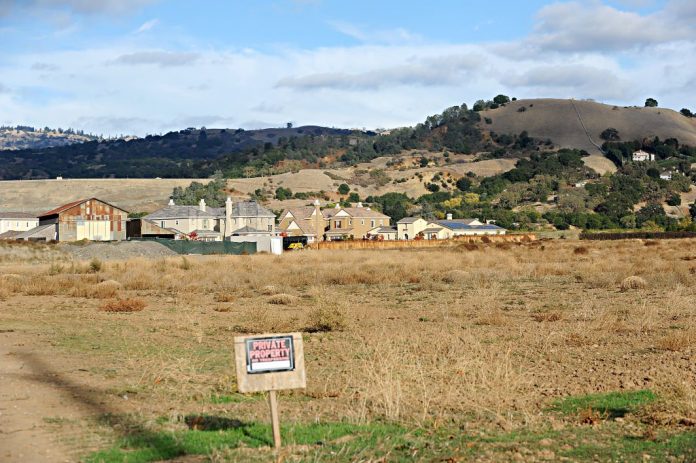
How harmful soil toxins returned to a 10-acre plot of land in northeast Morgan Hill where local school officials plan to build a brand new $20 million elementary school remains a mystery.
Meanwhile, state officials are in the process of informing hundreds of residents of the upcoming property cleanup plan, and assessing the neighbors’ concerns about the nearby presence of agriculture-related toxins.
More than 10 years ago, the same property, farmed by the Borello family for decades before being donated to the school district, was cleared by the State Department of Toxic Substances Control after a bioremediation process was used to cleanse the soil.
However, the same dangerous pesticides, including dieldrin and toxaphene, were detected in the soil in 2014 when the school district hired an environmental consultant to conduct its own site assessment.
“DTSC certified the site in 2005,” according to Jorge Moreno of the DTSC’s Office of Communications, who answered questions posed by the Times in email form.
School officials, desperate to lock up any remaining plots of land within the city large enough to build new schools, are eager to find an effective resolution. On Wednesday, Assistant Superintendent Kirsten Perez said: “Given the serious nature of the toxins, staff is recommending that we off-haul the contaminated soil instead of using bio-remediation.”
While the concentrations of dieldrin (which has been known to cause cancer) and toxaphene, the Contaminant of Concern, were below the remediation goals upon testing, “After certification, the property was used for agricultural purposes again,” Moreno noted. “DTSC cannot speculate as to what happened at the site between 2005 and now.”
The property in question is located on Peet Road at Mission Avenida, and the only remnants of its past agricultural use is an old wooden barn that sits toward the back end of the property.
As part of the process, the DTSC also sent out notification letters and surveys to 422 residents and businesses in the surrounding area to keep them informed of the cleanup project. Sixty-nine residents filled out and mailed back the surveys, according to Moreno.
“The surveys, and introductory cover letter, provide us with an opportunity to introduce a project to a community, educate the public, and invite early feedback,” he said.
State officials will then develop a community profile for public review at a local information repository during and after the 30-day comment period for the draft Removal Action Workplan.
Occupying the former farmland surrounding the future school site are affluent neighborhoods of executive houses, priced at more than $1 million in today’s market, surrounding the open field meant for a new elementary school. The site also borders a Santa Clara Valley Water District pump station.
“There is some history on this particular piece from the Borellos in that the toxins were on it and the Borellos cleaned it up,” said veteran developer Richard Oliver, the president of Dividend Homes, which has built dozens of homes in the nearby Mission Ranch and Alicante neighborhoods. “No one to this day can explain to me or themselves how the toxins came back. It’s a mystery to us. We all assumed it was taken care of.”
Five-year resident Enrique Rivera, 45, who lives a few blocks west in the Mission Ranch development, said his biggest concern was the amount of development in the scenic area rather than soil toxins at the Borello property.
“Part of what we like about this neighborhood is all the open spaces,” said Rivera, who enjoys seeing the wildlife roaming around when he goes on walks with his family. “It’s all going away now.”
Soil cleanup a common process for developers
Oliver has been developing new housing throughout the Bay Area since 1972 and in Morgan Hill since 1980. He said soil remediation is “very common” when building on former farmland. However, Dividend Homes developments in that northeast Morgan Hill area are on former dairyland, rather than on one-time crop or orchard fields where pesticides were used.
“Our property that we developed came from Lawrence’s Dairy Farm so it did not have the toxins,” said Oliver, wanting to make it clear that his soil was safe even before he developed the homes.
Dividend Homes is also planning to develop seven plots for seven homes on a thin strip of land off Altimira Circle that borders the southeast corner of the old Borello property where the new school is being planned. Oliver said they are faced with a similar issue as the school district with those particular plots.
“We’re working with the state to be sure we get it cleaned up. That is still being determined,” said Oliver. He noted that requirements for reducing toxin levels in the soil are more stringent for school use than for residential.
When the city purchases land for development, like they did last year in the Southeast Quadrant for a future ball field, a site assessment is conducted and, if any soil cleanup is necessary, that cost falls on the owner, according to Anthony Eulo, program administrator with the city’s Environmental Services Division.
“The existing owner must clean up the site to a certain level before we even finish the sale, and that depends on the usage of the property,” said Eulo, who agreed it is “typical” to have to do some sort of cleanup on old farm land.
In the case of the Borello property, the school district’s consultants must determine a Removal Action Workplan for soil remediation, which is already under way. The state is responsible for “assessing, investigating and cleaning up the proposed site.”
“DTSC ensures that selected properties are free of contamination or, if the properties were previously contaminated, that they have been cleaned up to a level that protects the students and staff who will occupy the new school,” Moreno detailed.
New school estimated opening is February 2019
School officials originally balked on the idea of building a school on the donated land after learning of the contaminated soil. However, they never abandoned the idea and are now going full bore on the project.
Construction of the new school is estimated to take 490 days, immediately following the soil cleansing through February 2019, according to school records. The school board approved a $1 million design contract earlier this year.
The school, which will be funded through the $198 million Measure G capital improvements bond along with developer fees, will be named “S.G. Borello Elementary School” in honor of the family making the donation. It is expected to serve up to 600 students in grades kindergarten through fifth.







